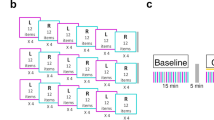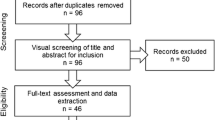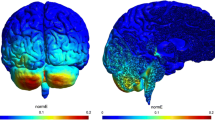Abstract
Neuroimaging studies suggest that the cerebellum contributes to human cognitive processing, particularly procedural learning. This type of learning is often described as implicit learning and involves automatic, associative, and unintentional learning processes. Our aim was to investigate whether cerebellar transcranial direct current stimulation (tDCS) influences procedural learning as measured by the serial reaction time task (SRTT), in which subjects make speeded key press responses to visual cues. A preliminary modeling study demonstrated that our electrode montage (active electrode over the cerebellum with an extra-cephalic reference) generated the maximum electric field amplitude in the cerebellum. We enrolled 21 healthy subjects (aged 20–49 years). Participants did the SRTT, a visual analogue scale and a visual attention task, before and 35 min after receiving 20-min anodal and sham cerebellar tDCS in a randomized order. To avoid carry-over effects, experimental sessions were held at least 1 week apart. For our primary outcome measure (difference in RTs for random and repeated blocks) anodal versus sham tDCS, RTs were significantly slower for sham tDCS than for anodal cerebellar tDCS (p = 0.04), demonstrating that anodal tDCS influenced implicit learning processes. When we assessed RTs for procedural learning across the one to eight blocks, we found that RTs changed significantly after anodal stimulation (interaction “time” × “blocks 1/8”: anodal, p = 0.006), but after sham tDCS, they remained unchanged (p = 0.094). No significant changes were found in the other variables assessed. Our finding that anodal cerebellar tDCS improves an implicit learning type essential to the development of several motor skills or cognitive activity suggests that the cerebellum has a critical role in procedural learning. tDCS could be a new tool for improving procedural learning in daily life in healthy subjects and for correcting abnormal learning in neuropsychiatric disorders.




Similar content being viewed by others
Abbreviations
- rTMS:
-
Repetitive transcranial magnetic stimulation
- SRRT:
-
Serial reaction time task
- tDCS:
-
Transcranial direct current stimulation
- VAS:
-
Visual analogue scale
References
Patten BM. The ancient art of memory. Usefulness in treatment. Arch Neurol. 1972;26:25–31.
Patten BM. The history of memory arts. Neurology. 1990;40:346–52.
Utz KS, Dimova V, Oppenlander K, et al. Electrified minds: transcranial direct current stimulation (tDCS) and galvanic vestibular stimulation (GVS) as methods of non-invasive brain stimulation in neuropsychology—a review of current data and future implications. Neuropsychologia. 2010;48:2789–810.
Baillieux H, De Smet HJ, Paquier PF, et al. Cerebellar neurocognition: insights into the bottom of the brain. Clin Neurol Neurosurg. 2008;110:763–73.
Manto M. The cerebellum, cerebellar disorders, and cerebellar research—two centuries of discoveries. Cerebellum. 2008;7:505–16.
Manto M, Haines D. Cerebellar research: two centuries of discoveries. Cerebellum. 2012;11:446–8.
O’Halloran CJ, Kinsella GJ, Storey E. The cerebellum and neuropsychological functioning: a critical review. J Clin Exp Neuropsychol. 2012;34:35–56.
Dayan E, Cohen LG. Neuroplasticity subserving motor skill learning. Neuron. 2011;72:443–54.
Meltzoff AN, Kuhl PK, Movellan J, et al. Foundations for a new science of learning. Science. 2009;325:284–8.
Welsh JP, Harvey JA. Cerebellar lesions and the nictitating membrane reflex: performance deficits of the conditioned and unconditioned response. J Neurosci. 1989;9:299–311.
Albus JS. Theory of cerebellar function. Math Biosci. 1971;10:25–61.
Marr D. A theory of cerebellar cortex. J Physiol. 1969;202:437–70.
Gilbert PF, Thach WT. Purkinje cell activity during motor learning. Brain Res. 1977;128:309–28.
Kitazawa S, Kimura T, Yin PB. Cerebellar complex spikes encode both destinations and errors in arm movements. Nature. 1998;392:494–7.
Seidler RD, Purushotham A, Kim SG, et al. Cerebellum activation associated with performance change but not motor learning. Science. 2002;296:2043–6.
Ferrucci R, Marceglia S, Vergari M, et al. Cerebellar transcranial direct current stimulation impairs the practice-dependent proficiency increase in working memory. J Cogn Neurosci. 2008;20:1687–97.
Ferrucci R, Giannicola G, Rosa M, et al. Cerebellum and processing of negative facial emotions: cerebellar transcranial DC stimulation specifically enhances the emotional recognition of facial anger and sadness. Cogn Emot 2012;26:786-799.
Galea JM, Jayaram G, Ajagbe L, et al. Modulation of cerebellar excitability by polarity-specific noninvasive direct current stimulation. J Neurosci. 2009;29:9115–22.
Niessen MJ, Bullemer P. Attentional requirements of learning: evidence from performance measures. Cogn Psychol. 1987;19:1–32.
Pascual-Leone A, Grafman J, Clark K, et al. Procedural learning in Parkinson’s disease and cerebellar degeneration. Ann Neurol. 1993;34:594–602.
Posner MI. Orienting of attention. Q J Exp Psychol. 1980;32:3–25.
Christ A, Kainz W, Hahn EG, et al. The Virtual Family—development of surface-based anatomical models of two adults and two children for dosimetric simulations. Phys Med Biol. 2010;55:N23–38.
Parazzini M, Fiocchi S, Rossi E, et al. Transcranial direct current stimulation: estimation of the electric field and of the current density in an anatomical human head model. IEEE Trans Biomed Eng. 2011;58:1773–80.
Parazzini M, Rossi E, Rossi L, et al. Numerical estimation of the current density in the heart during transcranial direct current stimulation. Brain Stimul. 2012. doi:10.1016/j.brs.2012.05.007.
Robertson EM. The serial reaction time task: implicit motor skill learning? J Neurosci. 2007;27:10073–5.
Abrahamse EL, van der Lubbe RH, Verwey WB, et al. Redundant sensory information does not enhance sequence learning in the serial reaction time task. Adv Cogn Psychol. 2012;8:109–20.
Torriero S, Oliveri M, Koch G, et al. Interference of left and right cerebellar rTMS with procedural learning. J Cogn Neurosci. 2004;16:1605–11.
Silvanto J, Muggleton NG. New light through old windows: moving beyond the "virtual lesion" approach to transcranial magnetic stimulation. NeuroImage. 2008;39:549–52.
Paulus W. Outlasting excitability shifts induced by direct current stimulation of the human brain. Suppl Clin Neurophysiol. 2004;57:708–14.
Vigot R. Cerebellar long-term depression: a mechanism for learning and memory. Med Sci (Paris). 2003;19:437–41.
Womack M, Khodakhah K. Active contribution of dendrites to the tonic and trimodal patterns of activity in cerebellar Purkinje neurons. J Neurosci. 2002;22:10603–12.
Walter JT, Alvina K, Womack MD, et al. Decreases in the precision of Purkinje cell pacemaking cause cerebellar dysfunction and ataxia. Nat Neurosci. 2006;9:389–97.
Honda M, Deiber MP, Ibanez V, et al. Dynamic cortical involvement in implicit and explicit motor sequence learning. A PET study. Brain. 1998;121(Pt 11):2159–73.
Jenkins IH, Brooks DJ, Nixon PD, et al. Motor sequence learning: a study with positron emission tomography. J Neurosci. 1994;14:3775–90.
Petri HL, Mishkin M. Behaviorism, cognitivism and the neuropsychology of memory. Am Sci. 1994;82:30–7.
Squire LR. Declarative and nondeclarative memory: multiple brain systems supporting learning and memory. J Cogn Neurosci. 1992;4:232–43.
Doyon J, Song AW, Karni A, et al. Experience-dependent changes in cerebellar contributions to motor sequence learning. Proc Natl Acad Sci U S A. 2002;99:1017–22.
Exner C, Koschack J, Irle E. The differential role of premotor frontal cortex and basal ganglia in motor sequence learning: evidence from focal basal ganglia lesions. Learn Mem. 2002;9:376–86.
Poldrack RA, Sabb FW, Foerde K, et al. The neural correlates of motor skill automaticity. J Neurosci. 2005;25:5356–64.
Rauch SL, Whalen PJ, Savage CR, et al. Striatal recruitment during an implicit sequence learning task as measured by functional magnetic resonance imaging. Hum Brain Mapp. 1997;5:124–32.
Matsumura M, Sadato N, Kochiyama T, et al. Role of the cerebellum in implicit motor skill learning: a PET study. Brain Res Bull. 2004;63:471–83.
Ungerleider LG, Doyon J, Karni A. Imaging brain plasticity during motor skill learning. Neurobiol Learn Mem. 2002;78:553–64.
Petrosini L, Molinari M, Dell’Anna ME. Cerebellar contribution to spatial event processing: Morris water maze and T-maze. Eur J Neurosci. 1996;8:1882–96.
Daum I, Rockstroh B, Birbaumer N, et al. Behavioural treatment of slow cortical potentials in intractable epilepsy: neuropsychological predictors of outcome. J Neurol Neurosurg Psychiatry. 1993;56:94–7.
Brunoni AR, Nitsche MA, Bolognini N, et al. Clinical research with transcranial direct current stimulation (tDCS): challenges and future directions. Brain Stimul. 2012;5:175–95.
Nitsche MA, Paulus W. Transcranial direct current stimulation—update 2011. Restor Neurol Neurosci. 2011;29:463–92.
Polania R, Paulus W, Nitsche MA. Modulating cortico-striatal and thalamo-cortical functional connectivity with transcranial direct current stimulation. Hum Brain Mapp 2012;33:2499-2508.
Pope PA, Miall RC. Task-specific facilitation of cognition by cathodal transcranial direct current stimulation of the cerebellum. Brain Stimul 2012;5:84-94.
Hamada M, Strigaro G, Murase N, et al. Cerebellar modulation of human associative plasticity. J Physiol. 2012;590:2365–74.
Nielsen JB, Cohen LG. The Olympic brain. Does corticospinal plasticity play a role in acquisition of skills required for high-performance sports? J Physiol. 2008;586:65–70.
Nicolson RI, Fawcett AJ, Brookes RL, et al. Procedural learning and dyslexia. Dyslexia. 2012;16:194–212.
Siegert RJ, Weatherall M, Bell EM. Is implicit sequence learning impaired in schizophrenia? A meta-analysis. Brain Cogn. 2008;67:351–9.
Gomez-Beldarrain M, Garcia-Monco JC. The cerebellar cognitive affective syndrome. Brain. 1998;121(Pt 11):2202–5.
Conflict of Interest
Roberta Ferrucci is a stakeholder in Newronika s.r.l., a spin-off company of the Fondazione IRCCS Ca’ Granda Ospedale Maggiore Policlinico and the Università degli Studi di Milano.
Andre R. Brunoni reported no financial interests or potential conflicts of interest.
Marta Parazzini reported no financial interests or potential conflicts of interest.
Maurizio Vergari is a stakeholder in Newronika s.r.l., a spin-off company of the Fondazione IRCCS Ca’ Granda Ospedale Maggiore Policlinico and of the Università degli Studi di Milano.
Elena Rossi is supported by “Dote ricerca”: FSE, Regione Lombardia and Newronika srl., a spin-off company of the Fondazione IRCCS Ca’ Granda Ospedale Maggiore Policlinico and the Università degli Studi di Milano.
Manuela Fumagalli reported no financial interests or potential conflicts of interest.
Francesca Mameli is a stakeholder in Newronika s.r.l., a spin-off company of the Fondazione IRCCS Ca’ Granda Ospedale Maggiore Policlinico and the Università degli Studi di Milano.
Manuela Rosa reported no financial interests or potential conflicts of interest.
Gaia Giannicola reported no financial interests or potential conflicts of interest.
Stefano Zago reported no financial interests or potential conflicts of interest.
Alberto Priori is a stakeholder in Newronika s.r.l., a spin-off company of the Fondazione IRCCS Ca’ Granda Ospedale Maggiore Policlinico and of the Università degli Studi di Milano.
Author information
Authors and Affiliations
Corresponding author
Rights and permissions
About this article
Cite this article
Ferrucci, R., Brunoni, A.R., Parazzini, M. et al. Modulating Human Procedural Learning by Cerebellar Transcranial Direct Current Stimulation. Cerebellum 12, 485–492 (2013). https://doi.org/10.1007/s12311-012-0436-9
Published:
Issue Date:
DOI: https://doi.org/10.1007/s12311-012-0436-9




